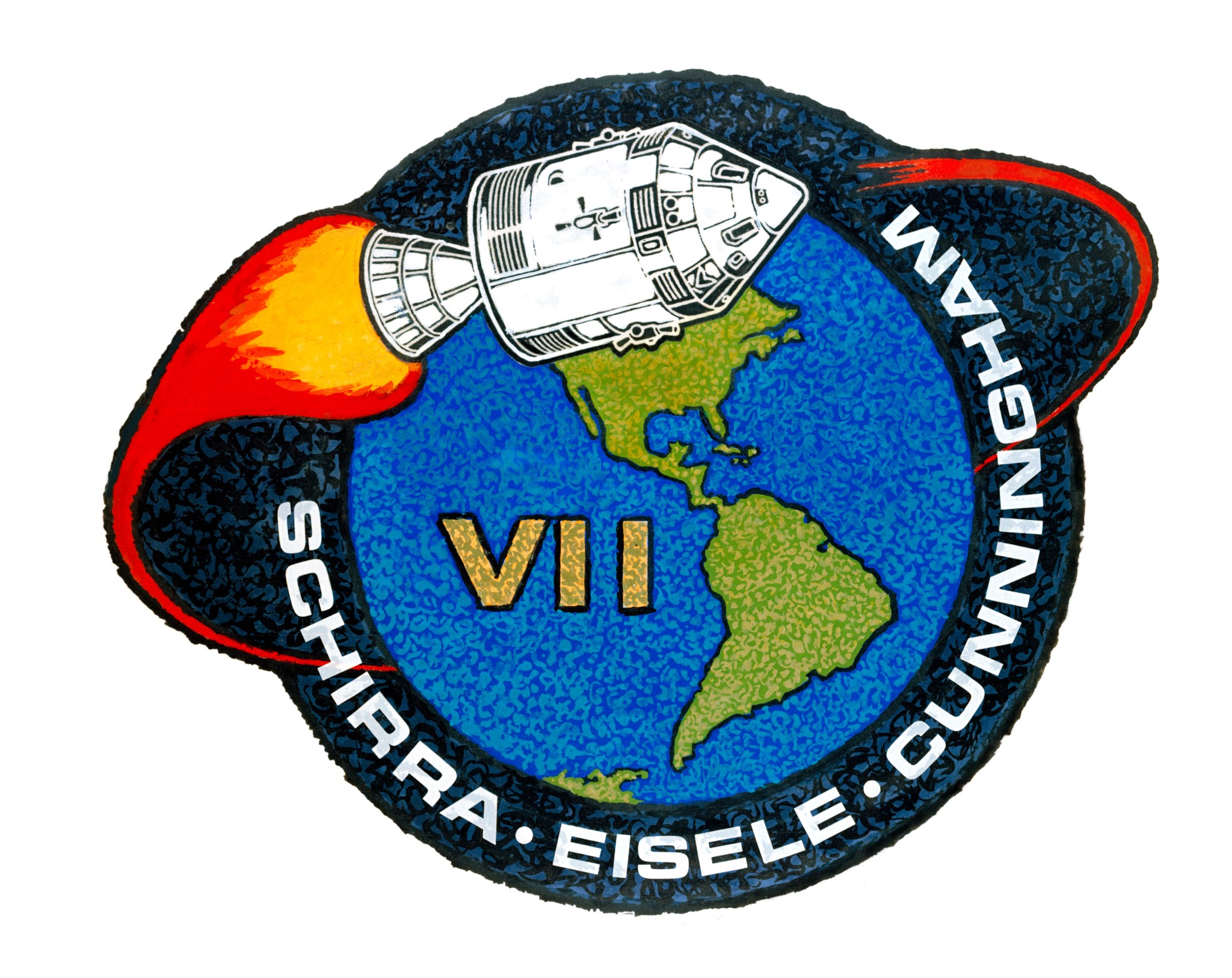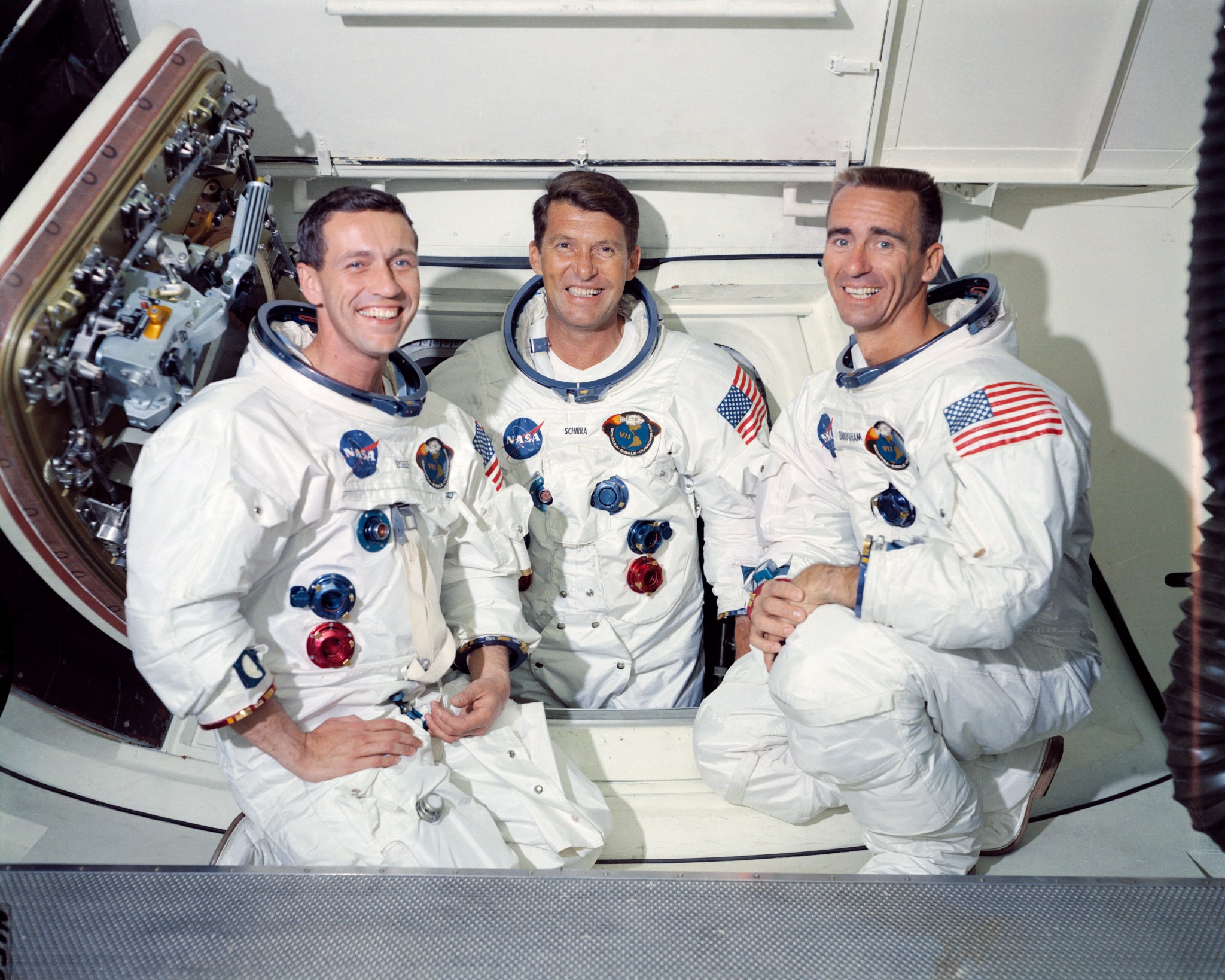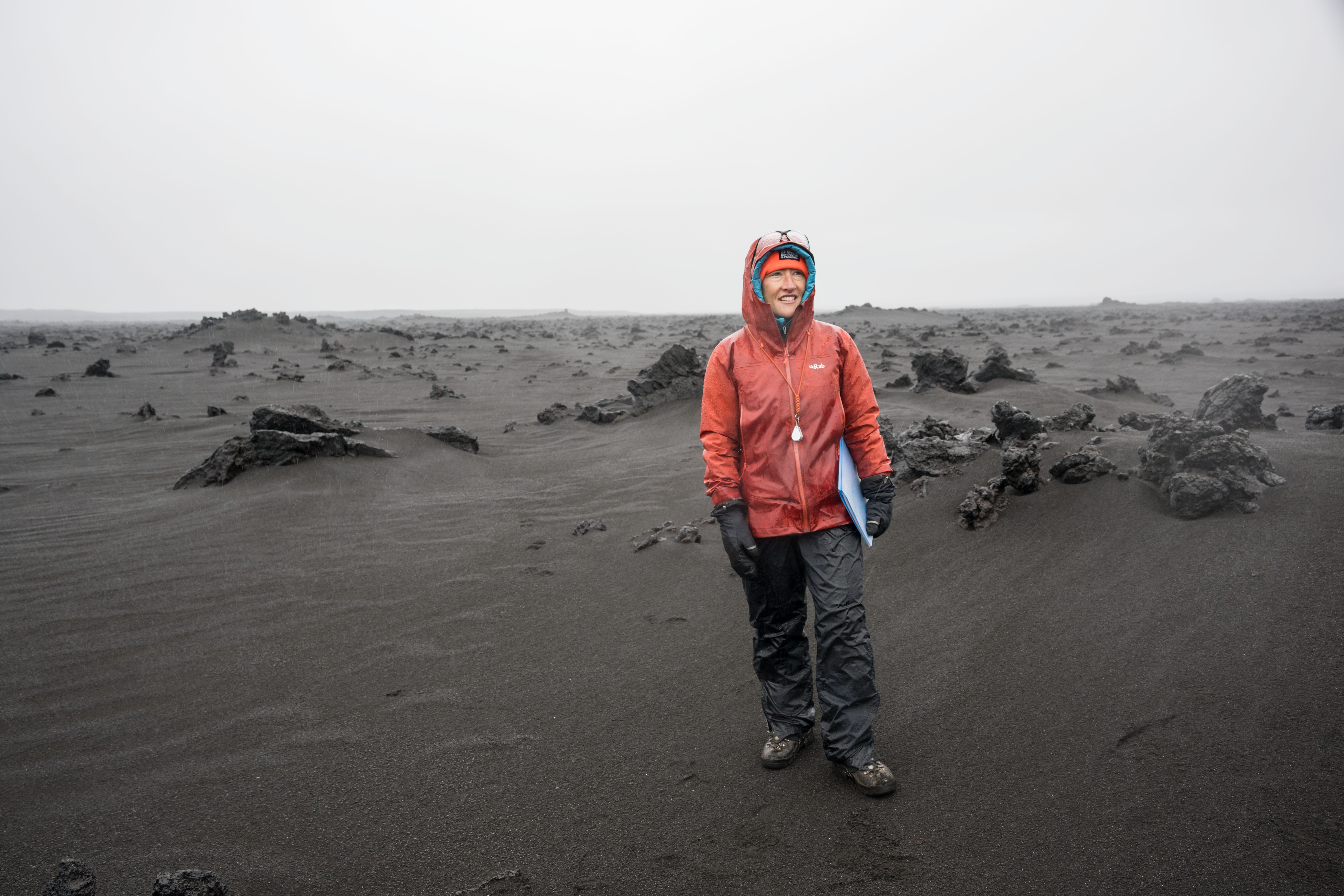“The Walt, Wally and Donn Show…”
Mission Objectives
Demonstrate Command and Service Module (CSM) with crew performance; demonstrate mission support facilities’ performance during a crewed mission and demonstrate Apollo rendezvous capability; demonstrate live TV broadcasts from space.
Mission Overview
Oct. 11, 1968, was a hot day at Cape Canaveral, but a pleasant breeze tempered the Florida heat when Apollo 7 lifted off from Launch Complex 34 in a blaze of orange-colored flames. The Saturn IB, in its first trial launch with humans aboard—Wally Schirra, Donn Eisele and Walt Cunningham—provided a perfect launch. Once the vehicle cleared the launch pad, a three-shift mission control team—led by flight directors Glynn Lunney, Gene Kranz and Gerry Griffin—in Houston took over. The Saturn’s first stage separated more than 2 minutes later allowing the second stage S-IVB to immediately take over. Commander Wally Schirra reported, “She is riding like a dream.” Just over 10 minutes after launch, Apollo 7 achieved an elliptical orbit of 140 -by -183 miles above Earth.
The S-IVB remained attached to the CSM for about one-and-a-half orbits until separation. Schirra fired the CSM’s small rockets to pull 50 feet ahead of the S-IVB, then turned the spacecraft around to simulate rendezvous and docking, as would be necessary to extract a Lunar Module (LM) for future Moon landings. The next day, when the CSM and the S-IVB were about 80 miles apart, Schirra and his crewmates sought out the lifeless 59-foot craft in a rendezvous simulation and approached within 70 feet. This involved the first two burns of the Service Propulsion System.
Cunningham reported the Spacecraft Lunar Module Adapter panels had not fully deployed, which naturally reminded Thomas Stafford, the mission’s capsule communicator, or capcom, of the “angry alligator” Agena target vehicle he had encountered on his Gemini IX mission. This mishap would have been problematic on a mission that carried an LM, but the panels would be jettisoned explosively on future flights.
Systems were operating normally but it was the crew who experienced some physical discomfort. About 15 hours into the flight, Schirra developed a bad cold, and Cunningham and Eisele soon followed suit. A cold is uncomfortable enough on the ground, but in weightlessness it presents a different problem. Mucus accumulates, fills the nasal passages and does not drain from the head. The only relief is to blow hard, which is painful to the ear drums. The crew had no choice but to endure their symptoms with the help of aspirin and decongestants.
Apollo 7 also saw the first live TV broadcast of Americans from space, but allowing it was a source of serious debate in NASA councils. The decision to carry a 4.5-pound video camera was made just before the mission and the crew held the first of seven TV broadcasts on Flight Day 4 (Oct. 14). Although these early pictures were crude, they served as educational moments for the public.
Service Module (SM) engine performance was a joy. This was one area where the crew could not switch to a redundant or backup system. At crucial times during a lunar voyage, the engine simply had to work or they would not get back home. On Apollo 7, all 8 firing attempts were nearly perfect. On the first attempt, the crew had a real surprise. In contrast to the smooth liftoff of the Saturn, the blast from the SM engine jolted the astronauts, causing Schirra to yell, “Yabadabadoo!,” like cartoon character Fred Flintstone. Later, Eisele said, “We didn’t quite know what to expect, but we got more than we expected,” adding that it felt like being plastered into their seats.
The Apollo CSM performed superbly. The spacecraft performed nominally for nearly 11 days—longer than a journey to the Moon and back. With few exceptions, the other systems in the spacecraft operated as they should. Occasionally, one of the three fuel cells supplying electricity to the craft developed some unwanted high temperatures, but load-sharing hookups among the cells prevented any power shortage. The crew complained about noisy fans in the environmental circuits and turned off two of them. The cabin stayed comfortable, although the coolant lines sweated and water collected in small puddles on the deck, something fellow astronaut Joe Kerwin had seen during training in one of NASA’s altitude chambers. Schirra and the crew vacuumed the excess water out into space using the urine dump hose.
A momentary shudder went through the Mission Control Center in Houston when both AC buses dropped out of the spacecraft’s electrical system, coincident with automatic cycles of the cryogenic oxygen tank fans and heaters. Manual resetting of the AC bus breakers restored normal service.
Three of the five spacecraft windows fogged because of improperly cured sealant compound, a condition that was not fixed until Apollo 9. Visibility from the spacecraft windows ranged from poor to good during the mission. Shortly after the launch escape tower jettisoned, two of the windows had soot deposits and two others had water condensation. Two days later, however, Cunningham reported that most of the windows were in fairly good shape, despite moisture collecting between the inner panes of one window.
Even with these minor impediments, the windows were adequate. Those used for observations during rendezvous and station-keeping with the S-IVB remained almost clear. Navigational sighting with a telescope and a sextant on any of the 37 preselected Apollo stars was difficult if done too soon after a waste-water dump. Sometimes they had to wait several minutes for the frozen particles to disperse. Eisele reported that unless he could see at least 40 or 50 stars at a time he found it hard to decide what part of the sky he was looking toward. On the whole, however, the windows were satisfactory for general and landmark observations and for out-the-window photography.
Chargers for the batteries needed for re-entry after fuel cells departed with the SM returned 50-75 percent less energy than expected. Most serious was the potential overheating of fuel cells, which might have failed when the spacecraft was too far from Earth to return on batteries, even if fully charged. Thankfully each of these anomalies was satisfactorily tested before Apollo 8 flew.
Several days before the mission ended, they began to wonder about their re-entry suit helmets. How would they blow their noses? The buildup of pressure might burst their eardrums. Deke Slayton in mission control tried to persuade them to wear the helmets anyway, but Schirra was adamant about keeping them off. (Ultimately, each crew member took a decongestant pill about an hour before re-entry and descended without incident.)
The CSM’s service propulsion system, which had to fire the CSM into and out of the Moon’s orbit on later missions, worked perfectly during eight burns lasting from half a second to 67.6 seconds. The crew splashed down in the Atlantic Ocean southeast of Bermuda, just over a mile from the planned impact point. The voyagers were picked up by helicopter and deposited on the deck of the U.S. Navy’s recovery ship USS Essex.
Apollo 7 accomplished what it set out to do – qualifying the CSM and clearing the way for the proposed lunar orbit mission to follow. Its activities were of national interest. A special edition of NASA’s news clipping collection called “Current News” included front page stories from 32 major newspapers scattered over the length and breadth of the nation. Although the post-mission celebrations may not have rivaled those for the first orbital flight of an American, John Glenn in 1962, enthusiasm was high and this fervor would build to even greater heights with each Apollo milestone.
Apollo 7’s achievement led to a rapid review of Apollo 8’s options. The Apollo 7 astronauts went through six days of debriefing for the benefit of Apollo 8, and on Oct. 28, 1968, the Manned Space Flight Management Council chaired by George Mueller, NASA Associate Administrator for Manned Space Flight, met at the Manned Spacecraft Center (now Johnson Space Center), investigating every phase of the forthcoming mission. The next day brought a lengthy systems review of the Apollo 8 spacecraft components. NASA Administrator Thomas Paine made the go/no-go review of lunar orbit on Nov. 11, 1968, at NASA Headquarters in Washington, D.C.
Crew
Walter Schirra Jr., Commander
R. Walter Cunningham, Lunar Module Pilot
Donn F. Eisele, Command Module Pilot
Backup Crew
Thomas Stafford, Commander
Eugene Cernan, Lunar Module Pilot
John Young, Command Module Pilot
Payload
CSM-101
Prelaunch Milestones
3/28/68 – Saturn 1B ondock at Kennedy
4/7/68 – Saturn IVB ondock at Kennedy
4/11/68 – S-IU (instrumentation unit) ondock at Kennedy
5/11/68 – launch vehicle at Launch Complex 34
8/9/68 – spacecraft at Launch Complex 34
9/17/68 – Countdown Demonstration Test
Launch
Oct. 11, 1968; 11:02:45 a.m. EST
Launch Complex 34
Saturn-IB AS-205
First Block II Apollo CSM
First crewed Apollo CSM mission
First three-person American crew
First live TV downlink
Orbit
Altitude: 141.65 miles
Inclination: 31.608 degrees
Orbits: 163 revolutions
Duration: 10 days, 20 hours, nine minutes, three seconds
Distance: 4,546,918.3 miles
Landing
Oct. 22, 1968; 7:11:48 a.m. EDT, Atlantic Ocean
Recovery Ship: USS Essex































